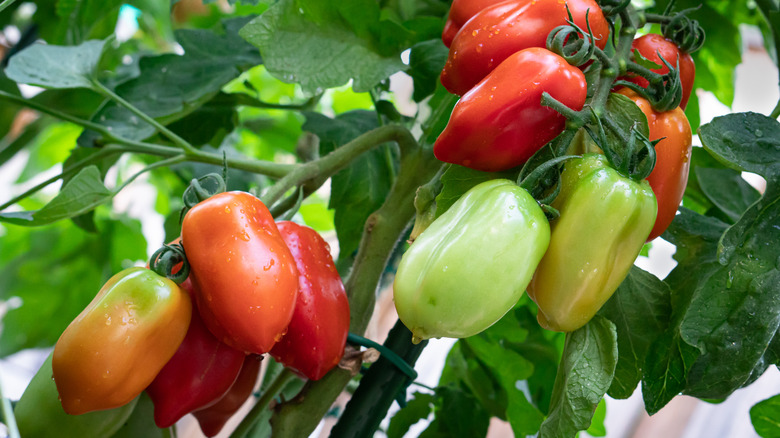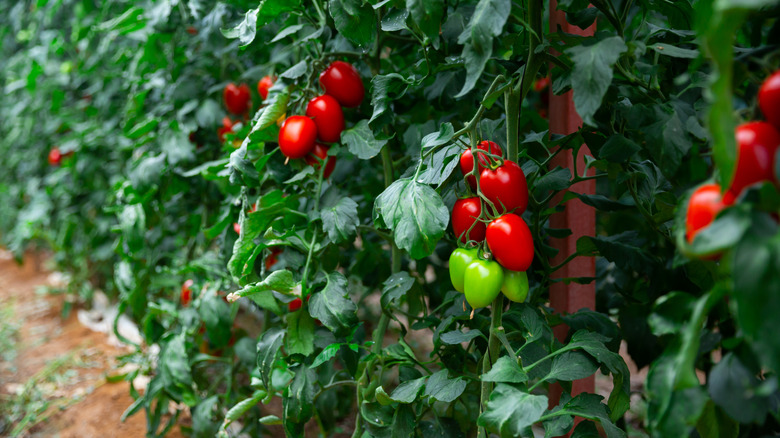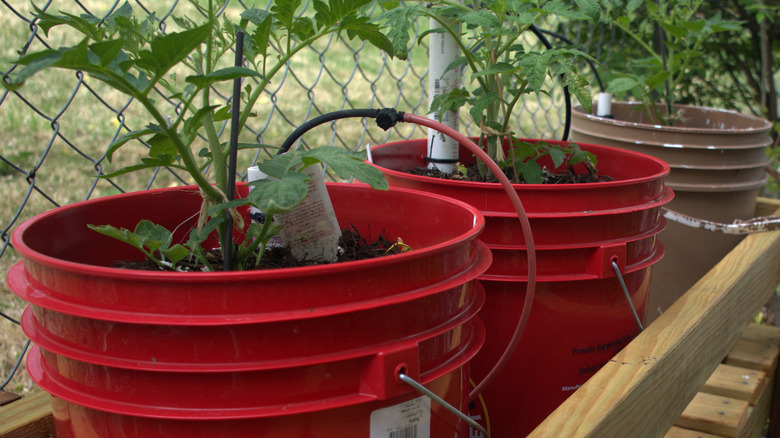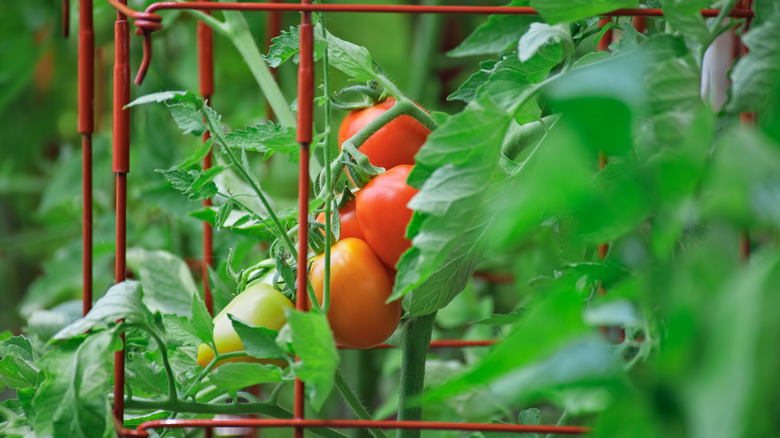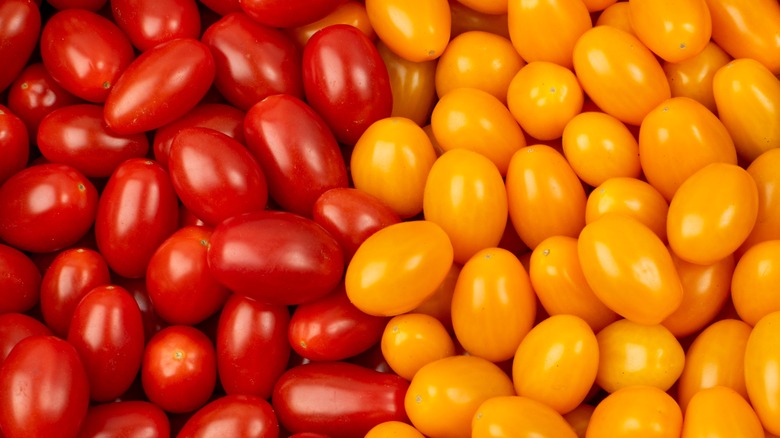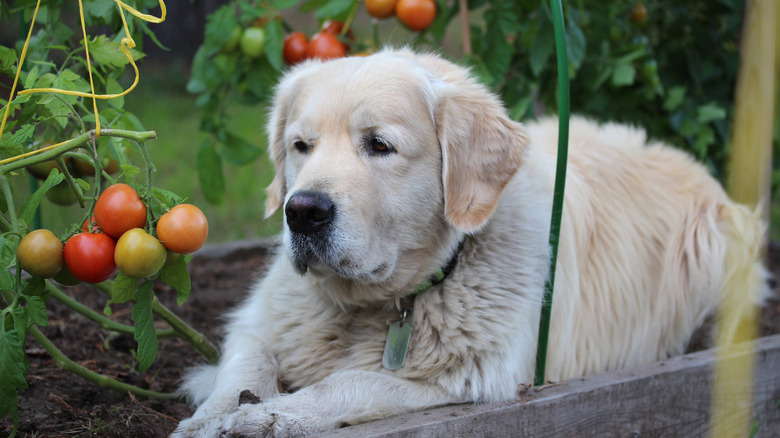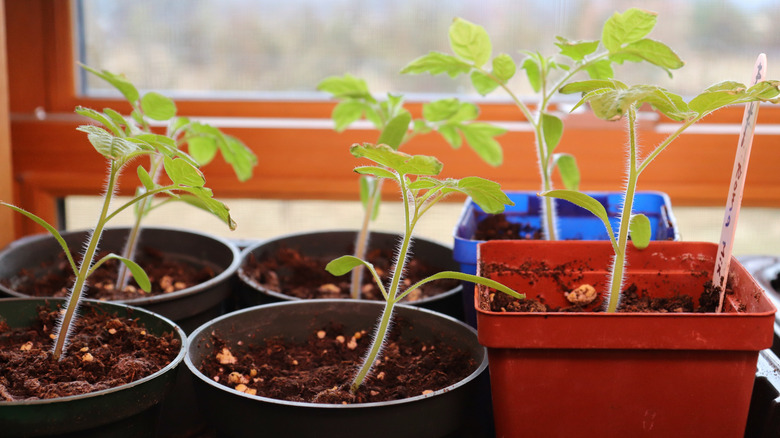How To Successfully Grow Roma Tomatoes
If you have ever dreamt of fresh tomato sauce just like grandma used to make, you should absolutely be adding roma tomatoes to your garden. The dense texture of roma tomatoes makes them perfect for pastes, sauces, salsas, and ketchup. Roma tomatoes (Solanum lycopersicum) are versatile plum tomatoes that grow well in both gardens and containers alike. Gardening Know How describes roma tomatoes as oblong in shape and grow to a length of about 3 inches. The thick flesh can vary from red to orange or yellow. The height of a mature tomato plant also ranges between 2 and 4 feet, depending on the variety, says SFGate.
The roma tomato is a hybrid species derived through open pollination with the San Marzano tomato and was first introduced in 1955, explains Nature's Produce. According to the USDA, roma tomatoes are the most produced variety of tomato in Mexico. This meaty variety of tomato is easy to grow, delicious, and popular for its resistance to diseases that are commonly found in tomato plants, such as verticillium wilt.
How to use roma tomatoes in garden
Roma tomatoes can be successful in both gardens and containers as long as temperatures remain between 55 and 90 degrees, says the Gardening Channel. It is vital that you don't bring your tomatoes outside until after the last threat of frost in your region because roma tomatoes are highly sensitive to cold temperatures, and they will die.
HGTV suggests planting your tomato plants in rows approximately 2 feet apart but leave 3 feet of space between rows so you can still maneuver in your garden without crushing your plants as you work. To plant in a container, only plant one roma tomato plant per container. Because the roots prefer to grow deep down into the soil, the container should be at least 2 feet wide and deep. Without room for the roots to stretch, the tomato plant won't be able to produce as many fruits, can't grow as tall, and could leave them prone to diseases. If you don't like how sparse a single tomato plant looks in a container of that size, plant a companion plant with shallow roots, such as marigolds.
How to grow roma tomatoes
If you're starting later in the season, roma tomatoes can be purchased as seedlings from garden centers. These will be hardened off and ready to be planted in your garden or containers. They can also be grown from seeds. Sow your seeds about a ½ inch deep in moist, well-draining soil about eight weeks before your region's last predicted frost date. To prevent the seedlings from getting leggy and collapsing, Gardening Channel suggests keeping your containers in a south-facing window. Alternatively, you can put them under a grow light. When the seeds begin to sprout, thin them so that they are about two inches apart. Maintain even moisture, but make sure you don't overwater. Your seedlings will be ready to be hardened off for planting once they reach about 6 inches tall (this should occur around the eight-week mark to coincide with the last frost).
To harden off your seedlings, take them outside and leave them in a shady area for a few hours a day or place them near an open window. Over the next week or two, allow your seedlings to get more and more exposure to direct sunlight. After a couple of weeks of regular exposure, your seedlings will be hardened off and ready to plant. Postpone hardening off your seedlings if temperatures are below 55 degrees, or you could overly stress your plants, leading to low fruit production, illness, or a very fast death.
How to care for roma tomatoes
As Gardening Channel notes, Roma tomatoes are very easy to care for. The greatest risk to them is frost. Roma tomatoes thrive in full sun environments but are also perfectly happy if they can receive around six hours of sun per day. Tomatoes require a large number of nutrients as they produce their fruit, so treat your roma tomatoes with rich organic soil and a slow-release fertilizer. According to Gardening Know How, the best fertilizer is one that is a 5-10-5 that is higher in phosphorus. As the plants are at the peak of the growing season and working to develop their fruit, it is important to water every two or three days, depending on the heat in your area. Once the weather cools, and the plants are no longer growing, scale back to a single weekly watering. Showering your entire tomato plant can not only attract pests, but it is also wasteful. Tomato plants cannot absorb water from their leaves or stem, so make sure you are watering directly at the base of the plant so the roots can absorb as much as possible.
Roma tomatoes are a determinate species, which means they only produce fruit over a five-week period during the growing season. While the growing conditions aren't complicated, it's important to consistently provide the ideal amounts of sunlight, water, and fertilizer so the plant has enough energy to maximize the amount of fruit produced. Infrequent watering can result in your tomatoes splitting.
Roma tomato varieties
While there are many varieties of roma tomatoes, they are all generally the same size of determinate bush and have roughly the same requirements for care. What truly sets them apart is the color and flavor of the fruits the plants produce.
- Balcony Garden Web says the Sunrise Sauce roma tomato's meaty texture is perfect for salsas and eating right from the vine. The yellow-orange skin is very easy to peel.
- The Heinz hybrid is larger than most roma tomatoes and is one of the most popular varieties because of its rich flavor.
- The Italian San Marzano variety produces the fruits in clusters. This variety is ideal for sauces because they are fleshier and have fewer seeds.
- Burpee Home Gardens celebrates the SuperSauce hybrid's enormous fruits –- a single fruit can weigh up to 2 lbs and make a full jar of delicious sauce.
- Cherry roma tomato plants produce delicious 2-inch fruits that are perfect for snacking or salads. This variety is indeterminate, meaning it bears fruit multiple times throughout the growing season.
Are roma tomatoes toxic?
Tomatoes, just like potatoes and eggplants, are members of the Solanaceae family –- also referred to as the nightshade family. There is a historic misconception that because they are in the nightshade family, the plant itself is dangerous. However, Gardening Know How explains that while they are cousins with the highly dangerous Belladonna nightshade, tomatoes produce a different alkaloid called tomatine, which is less toxic. The highest concentration of tomatine is found in leaves, stems, and unripened fruit. The ripe fruits are entirely safe to consume, both raw and cooked.
Eating a large number of stems and leaves can result in gastrointestinal distress in both humans and animals. The symptoms will be more intense in dogs than in humans. While it would not be fatal unless large amounts have been consumed, it's best to play it safe and keep your pets away from the tomato plants. If your dog has eaten a tomato plant and you are concerned, the ASPCA recommends contacting a local veterinarian if your pet exhibits any signs of distress, such as excessive salivating, vomiting, diarrhea, or loss of appetite.
How to repot roma tomatoes
Because of the hardy nature of the roma tomato plant, you can transplant your tomato plants anytime throughout the season, even while they are producing buds, says SFGate. If you are transferring to a container, use a soil mixture of potting soil and vermiculite, says Gardening Channel. Standard potting soil becomes too overbearing, and the roots will struggle to get enough oxygen, which can result in your plants contracting diseases, producing less fruit, or dying.
To avoid later damage to established roots, Gardening Channel also suggests you install any trellis or tomato cage first before placing the root ball deep enough for the first leaves to be covered or at surface level. Fill gaps with soil, then pack the soil down firmly around the stem before watering. Until the roots continue to grow, keep the repotted plant out of heavy winds and high heat because the stressed plants will be more susceptible to damage and illness until it begins pulling nutrients from the new soil.
